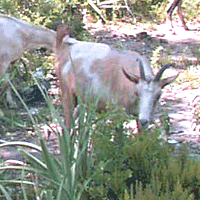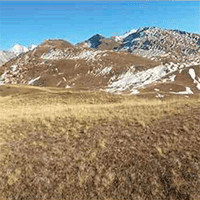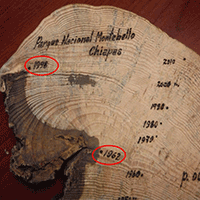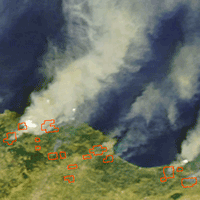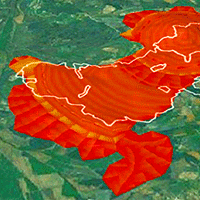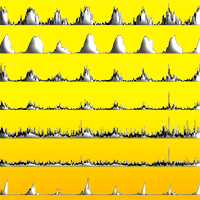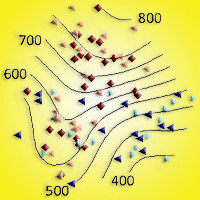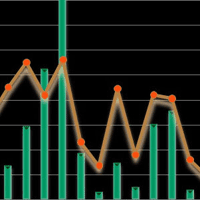Fuel treatments aimed at reducing both horizontal and vertical continuity in fuels are of paramount importance as a prevention measure against fire propagation. Possible techniques include pruning, thinning (mainly low thinning), mastication, prescribed burning, and prescribed (or targeted) grazing. Their main target is crown fire avoidance by treating surface fuels and promoting low density and vertically discontinuous stands, thus eliminating fuel ladders. Grazing is an effective, nearly carbon-neutral weed control technique which is cost-effective, nontoxic, and nonpolluting. Goat grazing is a very interesting solution: if confined by a metallic or electrified fence within a restricted pen, with a rather high density, goats browse the available foliage and twigs from all woody plants as well as all herbaceous vegetation. They can feed on a variety of shrubs, some of which are useless for other domestic species, and are therefore the best adapted for the consumption of all the Mediterranean shrubs which represent the fuel ladder. The appropriate choice of season of grazing, type of plant species and type and amount of biomass to be eliminated, livestock density, social structure of the herd, grazing time per day, type of fencing, and size of pens define the prescribed grazing system.
Keywords
, , , , , ,
Citation
Lovreglio R, Meddour-Sahar O, Leone V (2014). Goat grazing as a wildfire prevention tool: a basic review. iForest 7: 260-268. - doi: 10.3832/ifor1112-007
Academic Editor
Raffaele Lafortezza
Paper history
Received: Aug 25, 2013
Accepted: Nov 18, 2013
First online: Mar 26, 2014
Publication Date: Aug 01, 2014
Publication Time: 4.27 months
© SISEF - The Italian Society of Silviculture and Forest Ecology 2014
Open Access
This article is distributed under the terms of the Creative Commons Attribution-Non Commercial 4.0 International (https://creativecommons.org/licenses/by-nc/4.0/), which permits unrestricted use, distribution, and reproduction in any medium, provided you give appropriate credit to the original author(s) and the source, provide a link to the Creative Commons license, and indicate if changes were made.

Breakdown by View Type
(Waiting for server response...)
Article Usage
Total Article Views: 90017
(from publication date up to now)
Breakdown by View Type
HTML Page Views: 71708
Abstract Page Views: 6776
PDF Downloads: 9463
Citation/Reference Downloads: 104
XML Downloads: 1966
Web Metrics
Days since publication: 4305
Overall contacts: 90017
Avg. contacts per week: 146.37
Article Citations
Article citations are based on data periodically collected from the Clarivate Web of Science web site
(last update: Mar 2025)
Total number of cites (since 2014): 63
Average cites per year: 5.25
Publication Metrics
by Dimensions ©
Articles citing this article
List of the papers citing this article based on CrossRef Cited-by.
(1)
AFP (2009)Google fields low-tech wildfire prevention: goats. Web site.
Online |
Gscholar
(2)
Anonymous (2012)Meat and dairy goats in cache county. Cooperative Extension, Utah State University, Logan, UT, USA, pp. 2.
Online |
Gscholar
(3)
Ascoli D, Catalanotti A, Valese E, Cabiddu S, Delogu G, Driussi M, Esposito A, Leone V, Lovreglio R, Marchi E, Mazzoleni S, Rutigliano F, Strumia S, Bovio G (2012)Prescribed burning experiences in Italy: an integrated approach to prevent forest fires. Forest@ 9 (1): 20-38. [in Italian with English abstract]
CrossRef |
Gscholar
(4)
Ascoli D, Lonati M, Marzano R, Bovio G, Cavallero A, Lombardi G (2013)Prescribed burning and browsing to control tree encroachment in southern European heathlands. Forest Ecology and Management 289: 69-77.
CrossRef |
Gscholar
(5)
Baraza E, Hodar JA, Zamora R (2009)Consequences of plant-chemical diversity for domestic goat food preference in Mediterranean forests. Acta Oecologica 35: 117-127.
CrossRef |
Gscholar
(6)
Beatson A (1810)Papers relating to the devastation committed by goats on the island of St. Helena, from the period of their introduction to the present time; comprising experiments, observations and hints, connected with agricultural improvement and planting. S. Solomon - J. Coupland Publishing, St. Helena, SC, USA, pp. 80.
Gscholar
(7)
Birot Y (2009)Living with wildfires: what science can tell us - a contribution to the science- policy dialogue. Discussion Paper 15, European Forest Institute, Joenssu, Finland, pp. 82.
Online |
Gscholar
(8)
Blanchemain A (1981)Paturage en forêt: quel est le problème? Forêt méditerranéenne 3 (1): 69.
Online |
Gscholar
(9)
Bonnier J (1981)Rôle du paturage dans la prévention des incendies de forêts. Forêt méditerranéenne 3 (1): 71-72.
Online |
Gscholar
(10)
Burgess K (2009)Goats do the yard work at Google headquarters. LA Unleashed, Los Angeles Times, 5 May 2009, Los Angeles, CA, USA.
Online |
Gscholar
(11)
Cabrero A (2009)Camp Williams using goats to fight wildfires. KSL.com, web site.
Online |
Gscholar
(12)
Cans R (1999)Toutes les forêts brûlent. Forêt méditerranéenne 20: 23-24.
Online |
Gscholar
(13)
Chapman CK, Reid CR (2004)Sheep and goats: ecological tools for the 21
st century. Extension AG/Sheep/2004-1, Utah State University, Logan, UT, USA, pp. 4.
Online |
Gscholar
(14)
Coffey L, Hale M, Wells A (2004)Goats: sustainable production overview. ATTRA, National Sustainable Agriculture Information Service, NCAT, Fayetteville, Arkansas, USA, pp. 24.
Online |
Gscholar
(15)
Calabri G (1981)Le p’turage et les incendies de forêts en Italie. Forêt méditerranéenne 3 (1): 61-64.
Online |
Gscholar
(16)
Cavara F (1914)La végétation de la Tripolitaine et l’utilisation économique et agraire de la nouvelle colonie. Naples. In: “Sand-dune fixation and afforestation in Libya” (Messines J ed). Unasylva 6: 50-58.
Online |
Gscholar
(17)
Correa JE (2012)Grazing systems. Pub. UNP-0007, Alabama Cooperative Extension System, Alabama A&M and Auburn Universities, Montgomery, AL, USA, pp. 4.
Online |
Gscholar
(18)
Costa Alcubierre P, Castellnou Ribau M, Larrañaga Otxoa de Egileor A, Miralles Bover M, Kraus PD (2011)Prevention of large wildfires using the fire types concept. EU Fire Paradox Publication, Barcelona, Spain, pp. 83.
Online |
Gscholar
(19)
Deeming J, Lancester JW, Fosberg MA, Furman RW, Schroeder MJ (1972)The national fire-danger rating system. Research Paper RM-84, Rocky Mountain Forest and Range Experiment Station, USDA Forest Service, Fort Collins, CO, USA, pp. 165.
Gscholar
(20)
Devendra C (1999)Goats: challenges for increased productivity and improved livelihoods. Outlook on Agriculture 28 (4): 215-226.
Online |
Gscholar
(21)
Diamond JM, Christopher A, Call CA, Devoe N (2009)Effects of targeted cattle grazing on fire behaviour of cheatgrass-dominated rangeland in the northern Great Basin, USA. International Journal of Wildland Fire 18: 944-950.
CrossRef |
Gscholar
(22)
Dimanche M, Coudour R (2005)The pastoralism, partner of forest fire management: 20 years of practices in Languedoc Roussillon region. In: Proceedings of the “2nd International Conference on prevention strategies for fires in Southern Europe, Forest management as a tool for wildfire prevention”. Barcelona (Spain) 9-11 May 2005. Centre Tecnològic Forestal de Catalunya, Barcelona, Spain, pp. 74-75.
Gscholar
(23)
Du Plessis I, Van der Waal C, Webb EC (2004)A comparison of plant form and browsing height selection of four small stock breeds - preliminary results. South African Journal of Animal Science 34 (Suppl. 1): 31-34.
Online |
Gscholar
(24)
EFIMED (2012)The fight against forest fires: an inconvenient truth? EFIMED Network News, Mediterranean Regional Office of the European Forest Institute, Barcelona, Spain, pp. 1.
Online |
Gscholar
(25)
Fernandes PM, Botelho HS (2003)A review of prescribed burning effectiveness in fire hazard reduction. International Journal of Wildland Fire 12: 117-128
CrossRef |
Gscholar
(26)
Foroughbakhch R, Hernández-Piñero JL, Carrillo-Parra A, Rocha-Estrada X (2013)A composition and animal preference for plants used for goat feeding in semiarid northeastern Mexico. Journal of Animal and Plant Sciences 23 (4): 1034-1040.
Online |
Gscholar
(27)
Fuhlendorf SD, Archer SA, Smeins FE, Engle DM, Taylor CA (2008)The combined influence of grazing, fire, and herbaceous productivity on tree-grass interactions. In: “Western North American Juniperus Communities: A Dynamic Vegetation Type” (Van Auken OW ed). Ecological Studies Series, vol. 196, Springer, Berlin, Germany, pp. 219-238.
CrossRef |
Gscholar
(28)
Georgoudis A, Rosati A, Mosconi C (2005)Ani-mal production and natural resources utilisation in the Mediterranean mountain areas. EAAP Pub. 115, Wageningen Academic Publishers, Wageningen, The Netherlands, pp. 624.
Online |
Gscholar
(29)
Goetsch AL, Gipson TA, Askar AR, Puchala R (2009)Feeding behavior of goats. Journal of Animal Science 88 (1): 361-373.
CrossRef |
Gscholar
(30)
Govtrack US (2013)S. 1479: catastrophic wildfire prevention act of 2013. Web site.
Online |
Gscholar
(31)
Graham RT, McCaffrey S, Jain TB (2004)Science basis for changing forest structure to modify wildfire behavior and severity. Gen. Tech. Rep. RMRS-GTR-120, Rocky Mountain Research Station, USDA Forest Service, FortCollins, CO, USA, pp. 43.
Online |
Gscholar
(32)
Green LR, Newell LA (1982)Using goats to control brush regrowth on fuelbreaks. Gen. Tech. Rep. PSW-59, Pacific Southwest Forest and Range Experiment Station, USDA Forest Service, Albany, Ca, USA, pp. 13.
Online |
Gscholar
(33)
Guatieri G (1816)Dei vantaggi e dei danni derivanti dalle capre in confronto alle pecore [Benefits and damages resulting from the goats compared to sheep]. In: “Risorse silvo-pastorali, conflitto sociale e sistema alimentare: il ruolo della capra nelle comunità alpine della Lombardia e delle aree limitrofe in età moderna e contemporanea” (Corti M ed). SM Annali di S. Michele 19: 235-340. [in Italian]
Online |
Gscholar
(34)
Hagstrom K, Christiansen ML, Cleveland ER (1993)Plants in Hawaii that are eaten by goats. Journal of Hawaian and Pacific Agriculture 4: 101-105.
Gscholar
(35)
Haenlein GFW, Caccese R, Sammelwitz PH (1992)Behavior. In: “National Goat Handbook”. National Dairy Database, National Agricultural Library, University of Maryland, MD, USA, pp. 412.
Online |
Gscholar
(36)
Harrington TB (2012)Silvicultural basis for thinning southern pines: concepts and expected responses. Georgia Forestry Commission, Warnell School of Forest Resources, University of Georgia, Athens, GA, USA, pp. 20.
Online |
Gscholar
(37)
Harris S (2007)Colonial forestry and environmental history: British policies in Cyprus, 1878-1960. PhD Thesis, University of Texas, Austin, TX, USA, pp. 504.
Online |
Gscholar
(38)
Harris SE (2012)Cyprus as a degraded landscape or resilient environment in the wake of colonial intrusion. Proceedings of the National Academy of Sciences USA 109 (10): 3670-3675.
CrossRef |
Gscholar
(39)
Hart S (2001)Recent perspectives in using goats for vegetation management in the USA. Journal of Dairy Science 84: E170-E176.
CrossRef |
Gscholar
(40)
Hudak AT, Rickert I, Morgan P, Strand E, Lewis SA, Robichaud PR, Hoffman C, Holden ZA (2011)Review of fuel treatment effectiveness in forests and rangelands and a case study from the 2007 megafires in central Idaho, USA. Gen. Tech. Rep. RMRS-GTR-252, Rocky Mountain Research Station, USDA Forest Service, Fort Collins, CO, USA, pp. 60.
Online |
Gscholar
(41)
Hutchens T (2003)Kentucky goat friendly pasture concept. Goat Producer’s Newsletter, Cooperative Extension Service, Kentucky University, October-November 2003, pp. 1-4.
Gscholar
(42)
Ingram RS, Doran MP, Nader G (2013)Planned herbivory in the management of wildfire fuels. In: “Herbivory” (Barros B, Fernandes MEB eds). InTech, Rijeka, Croatia, pp. 76.
Online |
Gscholar
(43)
Kazuki (2009)Google is hiring (weed consumer wanted?). Kazuki Presents, web site.
Online |
Gscholar
(44)
Kirkpatrick JB, Marsden-Smedley JB, Leonard SWJ (2011)Influence of grazing and vegetation type on post-fire flammability. Journal of Applied Ecology 48 (3): 642-649.
CrossRef |
Gscholar
(45)
Knapp EE, Estes BL, Skinner CN (2009)Ecological effects of prescribed fire season: a literature review and synthesis for managers. Gen. Tech. Rep. PSW-GTR-224, Pacific Southwest Research Station, USDA Forest Service, Albany, CA, USA, pp. 80.
Online |
Gscholar
(46)
Jáuregui BM, García U, Osoro K, Celaya R (2009)Sheep and goat grazing effects on three atlantic heathland types. Rangeland Ecology and Management 62 (2) 119-126.
CrossRef |
Gscholar
(47)
Launchbaugh K, Walker J (2006)Targeted grazing - a new paradigm for livestock management. In: “Targeted grazing: a natural approach to vegetation management and landscape enhancement” (Launchbaugh K ed). American Sheep Industry Association - ASI, Washington, DC, USA, pp. 8.
Online |
Gscholar
(48)
Leone V (2002)Forest management: pre and post fire practices. In: “Fire, Landscape and Biodiversity: An Appraisal of the Effects and Effectiveness” (Pardini, G, Pintó, J eds). Diversitas, Universitat de Girona, Spain, pp. 117-141.
Gscholar
(49)
Leone V, Saracino A, Trabaud L, Velez R (2000)Fire management and prevention policies in west Mediterranean pine forests. In: “Ecology, Biogeography and Management of Mediterranean Pine Forest Ecosystems (
Pinus halepensis and
P. brutia)” (Ne’eman G, Trabaud L eds). Backhuys Publishers, The Hague, The Netherlands, pp. 335-354.
Gscholar
(50)
Leone V, Signorile A, Gouma V, Pangas N, Chronopoulou-Sereli A (1999)Obstacles in prescribed fire use in Mediterranean countries: early remarks and results of the Fire Torch project. In: Proceedings of the “DELFI International Symposium. Forest Fires: Needs and Innovations”. Athens (Greece) 18-19 Nov 1999. CINAR SA, Athens, Greece, pp. 132-136.
Gscholar
(51)
Lipson J, Reynolds T, Anderson L (2011)Environmental implications of livestock series: goats. EPAR Brief No. 156, Evans School of Public Affairs, University of Washington, Seattle, WA , USA, pp. 14.
Online |
Gscholar
(52)
Lopez-Trujillo R, Garcia-Elizondo R (1995)Botanical composition and diet quality of goats grazing natural and grass reseeded shrublands. Small Ruminant Research 16 (1): 37-47.
CrossRef |
Gscholar
(53)
Lu CD (1988)Grazing behavior and diet selection of goats. Small Ruminant Research 1: 205-216.
CrossRef |
Gscholar
(54)
Luginbuhl JM (2000)Pasture for meat goats. Langston University, Langston, OK, USA, pp. 39.
Online |
Gscholar
(55)
Luginbuhl JM, Pietrosemoli Castagni S (2007)Utilización de caprinos para el control de vegetación indeseable - Use of goats to control undesirable vegetation. Arch Latinoam Prod Anim 15 (Suppl. 1): 294-309.
Online |
Gscholar
(56)
Mancilla-Leytón JM, Pino Mejías R, Martín Vicente A (2012)Do goats preserve the forest? Evaluating the effects of grazing goats on combustible Mediterranean scrub. Applied Vegetation Science 16 (1): 63-73.
CrossRef |
Gscholar
(57)
Mancilla-Leytón JM, Martín Vicente A (2012)Biological fire prevention method: Evaluating the effects of goat grazing on the fire-prone Mediterranean scrub. Forest Systems 21 (2): 199-204.
CrossRef |
Gscholar
(58)
McGinty EL, Baldwin B, Banner R (2009)A review of livestock grazing and range management in Utah. Utah State University, Salt Lake City, UT, USA, pp. 45.
Online |
Gscholar
(59)
Mendenhall M (2004)Fighting fire with goats at Camp Williams. Utah Forest News, Utah Forest Landowner Education Program Newsletter 4: 4-5.
Online |
Gscholar
(60)
Messines J (1952)Sand-dune fixation and afforestation in Libya. Unasylva 6 (2): 50-58.
Online |
Gscholar
(61)
Molina D, Castellnou M, García-Marco D, Salgueiro A (2010)Improving fire management success through fire behaviour specialists. In: “Towards Integrated Fire Management Outcomes of the European Project Fire Paradox” (Silva JS, Rego F, Fernandes P, Rigolot E eds). Research Report 23, European Forest Institute, Joensuu, Finland, pp. 105-119.
Online |
Gscholar
(62)
Montiel C, Herrero G (2010)An overview of policies and practices related to fire ignitions at the European Union level. In: “Towards integrated fire management-outcomes of the european project fire paradox” (Silva JS, Rego F, Fernandes P, Rigolot E eds). Research Report 23, European Forest Institute, Joensuu, Finland, pp. 35-46.
Online |
Gscholar
(63)
Moser PM (2006)Regeneration and utilization of Faidherbia albida and Acacia erioloba along ephemeral rivers of Namibia. In: “Ecology and Development” (Denich M, Martius C, Rodgers C eds). Series No. 42, Cuvillier Verlag, Göttingen, Germany, pp. 122.
Online |
Gscholar
(64)
Nader G, Henkin Z, Smith E, Ingram R, Narvaez N (2007)Planned herbivory in the management of wildfire fuels. Rangelands 29: 18-24.
CrossRef |
Gscholar
(65)
Nastis AS (1997)Feeding behaviour of goats and utilsation of pasture and rangelands. In: “Recent advances in goat research” (Moran D, Fehr P eds). Cahiers Options Méditerranéennes 25: 39-45.
Gscholar
(66)
Nastis AS, Nolan T (1997)Some aspects of the use of vegetation by grazing sheep and goats. In: “Recent advances in small ruminant nutrition” (Lindberg JE, Gonda HL, Ledin I eds). Options Méditerranéennes, Série A, Séminaires Méditerranéens, vol. 34, pp. 11-25.
Gscholar
(67)
Omi PN, Martinson EJ (2002)Effects of fuels treatment on wildfire severity. Final report, Joint Fire Science Program Governing Board, Western Forest Fire Research Center, Colorado State University, Fort Collins, CO, USA, pp. 40.
Online |
Gscholar
(68)
Omi PN, Joyce LA (2003)Fire, fuel treatments, and ecological restoration. Tec. Rep. RMRS-P-29, Rocky Mountain Research Station, USDA Forest Servce, Fort Collins, CO, USA, pp. 475.
Online |
Gscholar
(69)
Otero I (2010)Matadepera, Barcelona metropolitan region. Peasant Memory for Wildfire Prevention, Spain, pp. 10.
Online |
Gscholar
(70)
Papanastasis VP (1986)Intégrer la chèvre à la forêt méditerranéenne . Unasylva 38: 44-52. [in French]
Online |
Gscholar
(71)
Papanastasis VP (2000)Land degradation caused by overgrazing and wildfires and management strategies to prevent and mitigate their effects. In: “EUR 19390 desertification in Europe: mitigation strategies, land-use planning” (Enne G, Zanolla C, Peter D eds). Advanced study course, Office for Official Publications of the European Communities, Luxembourg, pp. 509. [ISBN 92-828-9003-1]
Gscholar
(72)
Papanastasis VP (2004)Grazing lands and pastoral landscapes. LUCINDA (Land Care in Desertification Affected Areas: From Science towards Application), Booklet 5, n.5, pp. 40.
Online |
Gscholar
(73)
Papachristou T (1997)Foraging behaviour of goats and sheep on Mediterranean kermes oak shrublands. Small Ruminant Research 24 (2): 85-93.
CrossRef |
Gscholar
(74)
Pastor E, Pérez Y, Miralles M, Nebot E, Plana E (2006)Prescribed burning in Catalonia: fire management and research. In: Proceedings of the “10th Biennial Australasian Bushfire Conference 2006”. Brisbane (Australia) 6-9 June 2006. Paper No. 39300039, Griffith University, Brisbane, Australia, pp. 5.
Online |
Gscholar
(75)
Pittroff W, Narvaez N, Ingram R, Barry S, Nader G, Morgan Doran M (2006)Prescribed herbivory for fire fuels management. In: Proceedings of the Symposium “Society for Range Management” (Barry S, Risberg D). San Jose (CA, USA), 23 June 2006. California-Pacific Section Society for Range Management, University of California Cooperative Extension, San Jose, CA, USA, pp. 2.
Online |
Gscholar
(76)
Pollet J, Omi PN (2002)Effect of thinning and prescribed burning on crown fire severity in ponderosa pine forests. International Journal of Wildland Fire 11: 1-10.
CrossRef |
Gscholar
(77)
Rego F, Montiel C (2010)Lessons learned and the way ahead. In: “Best practices of fire use - prescribed burning and suppression fire programmes in selected case-study regions in Europe” (Montiel C, Krauss D eds). Research Report 24, European Forest Research Institute, Joensuu, Finland, pp. 165-169.
Online |
Gscholar
(78)
Ruiz-Mirazo J (2011)Environmental benefits of extensive livestock farming: wildfire prevention and beyond. Options Méditerranéennes 100: 75-82.
Online |
Gscholar
(79)
Ruiz-Mirazo J, Robles AB, González-Rebollar JL (2009)Pastoralism in natural parks of Andalucía (Spain): a tool for fire prevention and the naturalization of ecosystems. In: “Changes in sheep and goat farming systems at the beginning of the 21st century” (Pacheco F, Morand-Fehr P ds). CIHEAM-IAMZ, Zaragoza, Options Méditerranéennes, Série A, Séminaires Méditerranéens 91: 141-14.
Online |
Gscholar
(80)
Ruiz-Mirazo J, Robles AB (2012)Impact of targeted sheep grazing on herbage and holm oak saplings in a silvopastoral wildfire prevention system in south-eastern Spain. Agroforestry Systems 86 (3): 477-491.
CrossRef |
Gscholar
(81)
Seigue A (1985)La forêt circumméditerranéenne et ses problèmes. Collection Rechniques Agricoles et Productions Méditerranéennes no. 5, Maisonneuve et Larose, Paris, France, pp. 502.
Gscholar
(82)
Scott JH, Reinhardt ED (2001)Assessing crown fire potential by linking models of surface and crown fire behavior. Research Paper RMRS-RP-29, Rocky Mountain Research Station, USDA Forest Service, Fort Collins, CO, USA, pp. 59.
Online |
Gscholar
(83)
Siddle D (2009)Goats, marginality and the dangerous other. Environment and History 15 (4): 521-536.
CrossRef |
Gscholar
(84)
SRCD (2006)Grazing handbook a guide for resource managers in coastal California. Sotoyome Resource Conservation District, Pistil Books Online, Seattle, WA, USA, pp. 68.
Online |
Gscholar
(85)
Taylor CA (2006)Targeted grazing to manage fire risk. In: “Targeted grazing: a natural approach to vegetation management and landscape enhancement” (Launchbaugh K ed). American Sheep Industry Association - ASI, Washington, DC, USA, pp. 108-114.
Online |
Gscholar
(86)
Thirgood JV (1981)Man and the Mediterranean forest. A history of resource depletion. Academic Press, London, UK, pp. 194.
Gscholar
(87)
Tsiouvaras CN, Havlik NA, Bartolome JW (1989)Effects of goats on understory vegetation and fire hazard reduction in a coastal forest in California. Forest Science 35: 1125-1131.
Gscholar
(88)
USDA (2013)Goat grazing for fuels reductionon the Cleveland National Forests. Blog, posted June 19.
Online |
Gscholar
(89)
Vélez R (2010)Prescribed burning for improved grazing and social fire prevention: the Spanish EPRIF Program. In: “Best practices of fire use - prescribed burning and suppression fire programmes in selected case-study regions in Europe” (Montiel C, Krauss D eds). Research Report 24, European Forest Research Institute, Joensuu, Finland, pp. 117-122.
Online |
Gscholar
(90)
Vélez R (1990)Preventing forest fires through sylviculture. Unasylva 162 (41): 10-12.
Online |
Gscholar
(91)
Von Maydell HJ (1980a)Effects of goat husbandry on forest and range ecosystems. Journal of Plant Research and Development 12: 98-108.
Online |
Gscholar
(92)
Von Maydell HJ (1980b)Forstwirtschaft und Ziegenhaltung - Aufgaben im Rahmen der Waldweidewirtschaft [Forestry and goat keeping: suggestions for sylvo-pastoral management]. Forstarchiv 51 (4): 72-77.
Online |
Gscholar
(93)
Voth K (2009)Prevent or reduce fire with goats: no kidding! Joint Fire Science Program, Fire Science Brief 34: 1-6.
Online |
Gscholar
(94)
Walker JW (1994)Multispecies grazing: the ecological advantage. Sheep Research Journal (1994): 52-64.
Online |
Gscholar
(95)
Xanthopoulos G, Caballero D, Galante M, Alexandrian D, Rigolot E, Marzano R (2006)Forest Fuels Management in Europe. In: Proceedings of the “Fuels Management’How to Measure Success” (Andrews PL, Butler BW eds). Portland (OR - USA) 28-30 March 2006. RMRS-P-41, Rocky Mountain Research Station, USDA Forest Service, Fort Collins, CO, USA, pp. 29-36.
Online |
Gscholar
